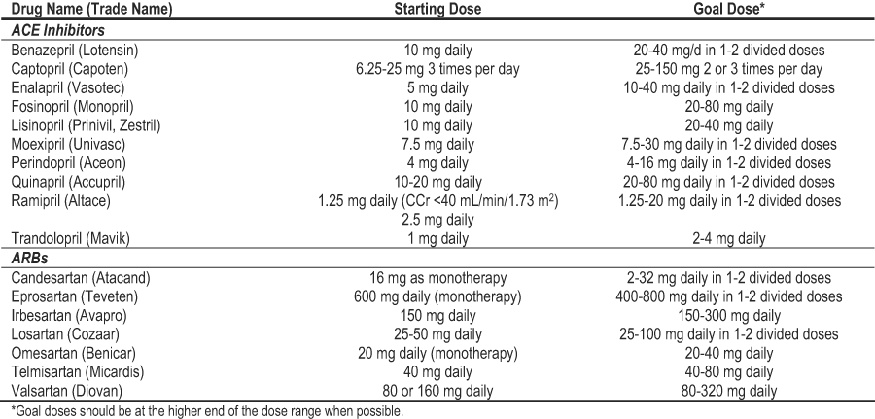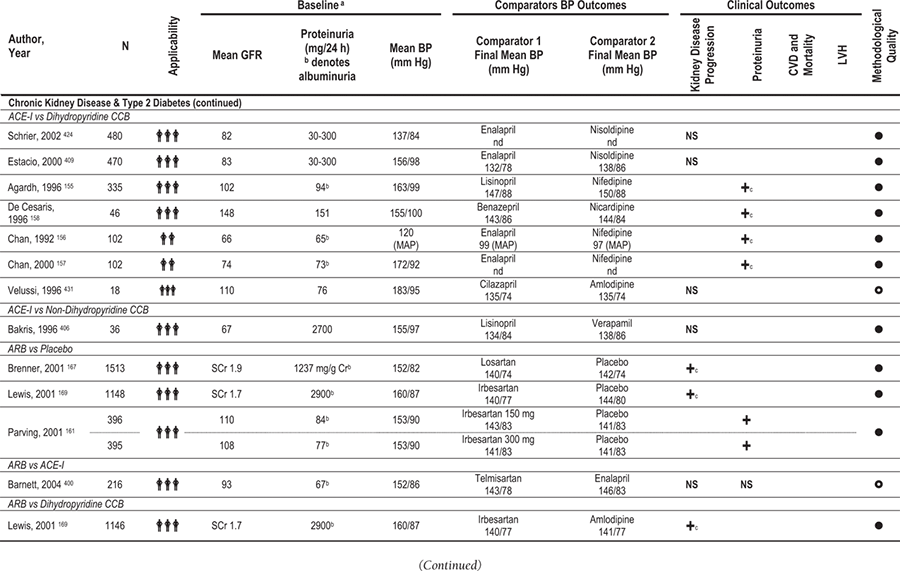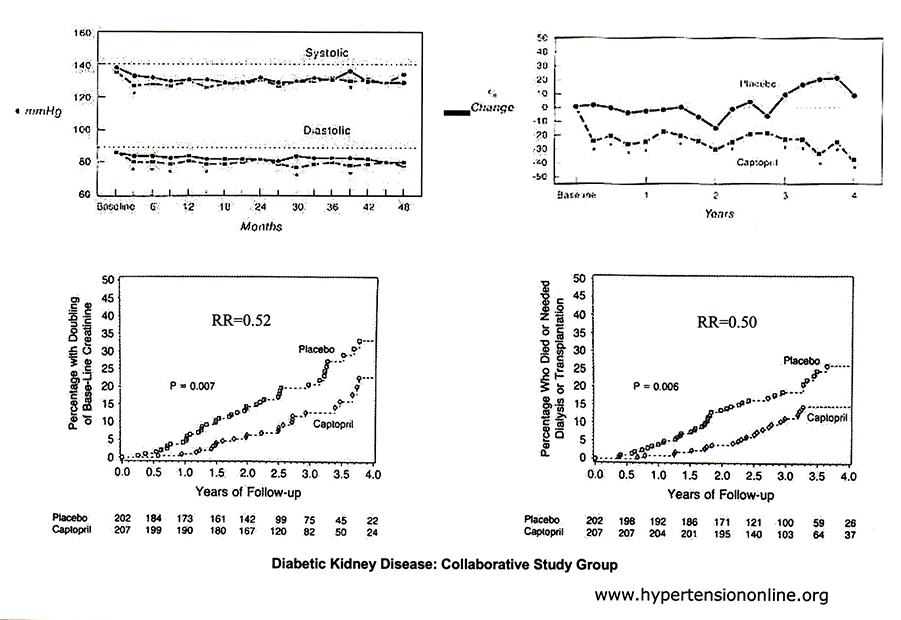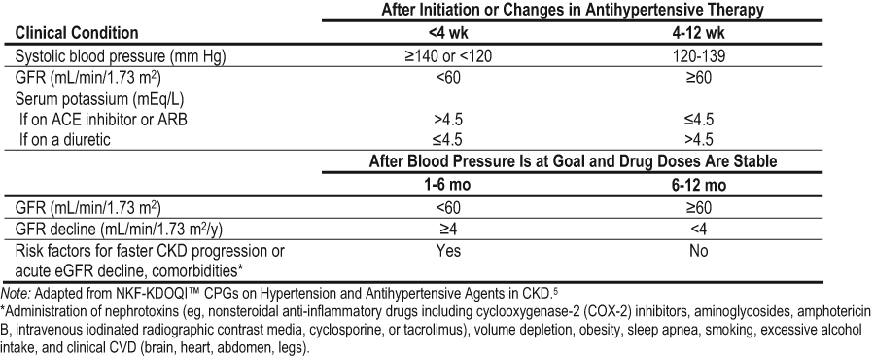
Most people with diabetes and CKD have hypertension. Treatment of hypertension slows the progression of CKD.
3.1 Hypertensive people with diabetes and CKD stages 1-4 should be treated with an ACE inhibitor or an ARB, usually in combination with a diuretic. (A)
3.2 Target blood pressure in diabetes and CKD stages 1-4 should be < 130/80 mm Hg. (B)
The natural history of DKD is characterized by hypertension, along with increasing albuminuria and decreasing GFR. In both type 1 and type 2 diabetes, the natural history is similar, with the exception that onset of hypertension and vascular disease is earlier in the course of kidney disease in type 2 diabetes.147, 148 A large number of epidemiological studies and controlled trials have defined hypertension as a risk factor for progression of DKD, and antihypertensive treatment reduces this risk.3
The purpose of this guideline is to provide a focused update of the diabetes and CKD section of the NKF-KDOQI™ CPGs on Hypertension and Antihypertensive Agents in CKD.5 The rapidly emerging literature in this field was reviewed to update the guidelines. A major difference in the present guideline is that the recommendation for ACE-inhibitor or ARB treatment in normotensive people with diabetes and microalbuminuria or macroalbuminuria was placed in CPR 1. This change was made because very few normotensive patients were included in existing studies and data are limited primarily to surrogate outcomes (albuminuria/proteinuria). Studies in which albuminuria reduction by RAS inhibition was a specified outcome also were reviewed. Because these studies were limited to secondary analyses of clinical trials of ARBs in patients with type 2 diabetes and DKD, this discussion also was placed in CPR 1.
For this guideline, studies of people with type 1 or type 2 diabetes and CKD stages 1 to 4 were included. Studies of kidney transplant recipients were excluded. Because of the high prevalence of diabetes, many individuals with other types of CKD also may have diabetes. In general, the guidelines for use of antihypertensive agents in kidney disease due to diabetes and other causes do not conflict.34,154
ACE inhibitors and ARBs were compared with other classes of antihypertensive agents. In these studies, diuretics frequently were used as additional antihypertensive agents to achieve blood pressure control. Few studies directly compared ACE inhibitors and ARBs with each other in DKD, and with the exception of 1 study,400 all focused on changes in blood pressure, rather than markers of kidney disease or clinical outcomes. In addition, data comparing other classes of antihypertensive agents are provided. The main recommendations for this guideline and for doses of ACE inhibitors and ARBs are shown in Table 27 and Table 28, respectively.
Most patients with DKD have hypertension. (Strong)
Hypertension is one of the most common comorbidities in DKD (Table 29).149-153 Because the studies cited in Table 29 were published before the JNC 7 report, hypertension generally was defined as blood pressure greater than 140/90 mm Hg. The JNC 7 defines hypertension in those with diabetes or CKD as blood pressure greater than 130/80 mm Hg. Thus, these prevalence estimates likely represent lower range values based on current criteria for hypertension in diabetes or CKD. The onset of hypertension in type 1 diabetes generally signifies the onset of DKD. Conversely, hypertension in type 2 diabetes may occur in the absence of DKD.
Table 27. Hypertension and Antihypertensive Agents in DKD

Table 28. Doses of ACE Inhibitors and ARBs for Adults

Higher levels of blood pressure are associated with more rapid progression of DKD. (Strong)
A number of prospective studies show a strong relationship between a higher level of blood pressure and an increased risk of kidney failure and worsening kidney function in DKD.401-403 Some studies suggest that higher systolic blood pressure is more important than higher diastolic blood pressure or high pulse pressure for kidney disease progression.173,403
ACE inhibitors and ARBs are effective in slowing progression of kidney disease characterized by microalbuminuria in hypertensive patients with type 1 or type 2 diabetes. (Moderate)
ACE inhibitors and ARBs decrease urine albumin excretion, slow the increase in albumin excretion, and delay the progression from microalbuminuria to macroalbuminuria in kidney disease due to type 1 or type 2 diabetes (Table 30).155-166 Although most patients in these studies were hypertensive, some patients were not (by conventional criteria) because of their early stage of kidney disease. Consequently, patients in the ACE-inhibitor or ARB group had lower mean blood pressure during follow-up than patients in the control group. A “head-to-head” comparison of an ACE inhibitor versus ARB in a small study of predominantly microalbuminuric hypertensive patients with type 2 diabetes and a GFR greater than 70 mL/min/1.73 m2 demonstrated equivalent efficacy of the 2 agents in slowing loss of kidney function, given similar levels of blood pressure reduction.400 Follow-up in most studies of microalbuminuric patients generally was in the range of 2 to 4 years, so GFR often was stable.
Table 29. Prevalence of Hypertension in DKD





Figure 13. Results from the CSG Captopril Trial.
Changes in (A) blood pressure and (B) proteinuria. Squares, captopril group; circles, placebo group. Cumulative event rates for (C) doubling of baseline serum creatinine and (D) for death, dialysis, or transplantation. Modified with permission.168
Because no trials of ACE inhibitors or ARBs in patients with diabetes and microalbuminuria have demonstrated a reduction in such clinical outcomes as CKD stage 5, doubling of serum creatinine level, or death, the Work Group concluded that evidence for treatment of microalbuminuric patients with these medicines is moderate. This represents a change in level of evidence grading from "strong" in the NKF-KDOQI™ CPGs on Hypertension and Antihypertensive Agents in CKD.5 At the time of the present review, the Work Group believed that the change in evidence grading would encourage studies of long-term outcomes and other types of agents. However, in the absence of participation in such a clinical trial, the Work Group recommends this treatment despite moderate evidence.
ACE inhibitors are more effective than other antihypertensive classes in slowing progression of kidney disease characterized by macroalbuminuria in hypertensive patients with type 1 diabetes. (Strong)
The CSG trial of captopril in diabetic nephropathy demonstrated that ACE inhibitors are effective in reducing albuminuria and slowing the decrease in GFR and onset of kidney failure in patients with type 1 diabetes and macroalbuminuria (Table 30).168,171,404,405 In the placebo group, blood pressure was controlled with other antihypertensive agents as necessary. Figure 13 shows results from the CSG trial.168 In that study, the beneficial effect of ACE inhibitors was greater in patients with decreased GFR at baseline, possibly because the end point, a doubling of baseline serum creatinine level, is achieved more quickly in patients with reduced GFR. The effects of ACE inhibitors may be caused in part by the antihypertensive effect and in part by additional mechanisms because kidney benefits appeared to be greater than expected for blood-pressure lowering.
Figure 14. Results from the IDNT.
Kaplan-Meier curves of the percentage of patients with (A) the primary composite end point and its individual components, (B) a doubling of the serum creatinine concentration, (C) CKD stage 5, and (D) death from any cause. Reprinted with permission.169
ARBs are more effective than other antihypertensive classes in slowing progression of kidney disease characterized by macroalbuminuria in hypertensive patients with type 2 diabetes. (Strong)
A number of high-quality randomized controlled trials demonstrate that ARBs are more effective than other antihypertensive drug classes in slowing the decline in GFR and onset of kidney failure in patients with type 2 diabetes and macroalbuminuria. Figure 14 and Figure 15 show the results from IDNT and the RENAAL, 2 large studies of patients with macroalbuminuria and decreased GFR at the time of enrollment.167,169 In these studies, the effects of ARBs may be caused in part by the antihypertensive effect and in part by additional mechanisms because kidney benefits appeared to be greater than expected for blood-pressure lowering.
ACE inhibitors may be more effective than other antihypertensive classes in slowing the progression of kidney disease characterized by macroalbuminuria in hypertensive patients with type 2 diabetes. (Weak)
Data on the efficacy of ACE inhibitors in kidney disease caused by type 2 diabetes are uncertain. Some studies show greater reduction in albuminuria and slower decrease in GFR compared with other hypertensive agents (Table 30).405-408 However, small sample size, use of surrogate outcomes, and inconsistent results preclude clear conclusions. A recent analysis of the subgroup of patients with type 2 diabetes and estimated GFR less than 60 mL/min/1.73 m2 enrolled in ALLHAT showed no beneficial effects of an ACE inhibitor (lisinopril) compared with a diuretic (chlorthalidone) or a calcium channel blocker (amlodipine) on decrease in GFR or onset of kidney failure during a 4-year interval when each agent was used separately.172 Of note, measures of albuminuria or proteinuria were not available in that study. Therefore, the Work Group concluded that the ALLHAT results do not rule out a beneficial effect of ACE inhibitors on DKD characterized by macroalbuminuria in type 2 diabetes.
Based on the shared properties of ACE inhibitors and ARBs in inhibiting the RAS and a recent small study,400 ACE inhibitors may be as effective as ARBs in slowing progression of kidney disease caused by type 2 diabetes. In the opinion of the Work Group, either ARBs or ACE inhibitors can be used to treat DKD in hypertensive people with type 2 diabetes and macroalbuminuria.
Figure 15. Reduction of End Points in Type 2 Diabetes with Losartan in RENAAL.
Kaplan-Meier curves of the percentage of patients with (A) the primary composite end point and its individual components,
(B) a doubling of the serum creatinine concentration, (C) CKD stage 5, and (D) the combined end point of CKD stage 5 or
death. Reprinted with permission.167
Figure 16. Systematic Review of Studies of DKD and Non-DKD.
The graph shows the change in blood pressure and proteinuria from baseline in trials that prospectively randomized various calcium antagonists and looked at either doubling of creatinine, CKD stage 5 and death, or rate of decrease in GFR. All studies used in this analysis also had a minimum of 1 year follow-up. Change in albuminuria was assessed in the context of outcomes of kidney disease. Abbreviations: DHP-CCB, dihydropyridine calcium channel blocker group; NDHP-CCB, nondihydropyridine calcium channel blocker group. Reprinted with permission.413
ARBs may be more effective than other antihypertensive agents in slowing progression of kidney disease characterized by macroalbuminuria in hypertensive patients with type 1 diabetes. (Weak)
There are insufficient data on the efficacy of ARBs in kidney disease caused by type 1 diabetes. The Work Group found no long-term clinical trials on the use of ARBs in patients with DKD caused by type 1 diabetes. However, based on the shared properties of both drug classes in inhibiting the RAS, ARBs may be as effective as ACE inhibitors in slowing progression of kidney disease caused by type 1 diabetes. In the opinion of the Work Group, ARBs can be used as an alternative class of agents to treat DKD in hypertensive people with type 1 diabetes and macroalbuminuria if ACE inhibitors cannot be used.
Diuretics may potentiate the beneficial effects of ACE inhibitors and ARBs in hypertensive patients with DKD. (Moderate)
Between 60% and 90% of patients in studies of hypertension treatment in DKD used either thiazide-type or loop diuretics in addition to ACE inhibitors or ARBs.167-169,409 Conversely, diuretic use in the ACE-inhibitor group of ALLHAT was restricted by protocol; only 18% of this group received a thiazide diuretic.172 Other studies have shown that the combination of thiazide diuretics with agents that block the RAS is more effective than either type of treatment alone for lowering blood pressure.410-412 Because most hypertensive patients with DKD require more than 1 antihypertensive agent to reach the target blood pressure of less than 130/80 mm Hg, it is the opinion of the Work Group that most of these patients should be treated with a diuretic in combination with an ACE inhibitor or an ARB to reach the target blood pressure.
Figure 17. Meta-Analysis of Studies of DKD and Non-DKD.
Effects of blood pressure-lowering agents in DKD and non-DKD. Shown are the weighted mean results with 95% CIs for proteinuria (bars) and blood pressure (bold print) that were obtained in studies that compared the effects of an ACE inhibitor(ACEi) with that of another blood pressure– lowering agent. (Left) Results obtained with ACE inhibitors are shown subdivided to the type of kidney disease (nondiabetic [nonDM] and diabetic nephropathy [DM]). (Right) Results obtained with the comparator drugs. Abbreviation: Uprot, urinary protein; MAP, mean arterial pressure. Reprinted with permission.414
ACE inhibitors, ARBs, and nondihydropyridine calcium channel blockers have a greater antiproteinuric effect than other antihypertensive classes in hypertensive patients with DKD. (Strong)
Two meta-analyses have demonstrated a greater effect of ACE inhibitors compared with other classes of antihypertensive agents on reducing proteinuria in DKD (Fig 16 and Fig 17) .413,414 Other studies show a larger effect of ARBs than other classes.415-417 Some studies also suggest that β-blockers may be effective, but this has not been observed consistently.418 A systematic review demonstrates that nondihydropyridine calcium channel blockers have substantially greater antiproteinuric effects than dihydropyridine calcium channel blockers, an effect that translated into greater slowing of kidney disease progression and reduced cardiovascular event rates in those with proteinuria greater than 300 mg/d.413 In contrast to the benefits of nondihydropyridine calcium channel blockers for reducing proteinuria, the Bergamo Nephrologic Diabetes Complications Trial (BENEDICT) recently reported that nondihydropyridine calcium channel blockers used alone did not decrease the incidence rate of microalbuminuria relative to placebo in hypertensive patients with type 2 diabetes with normal urinary albumin excretion at baseline. Additionally, they did not enhance the effect of ACE inhibitors to prevent microalbuminuria when used in combination.419
The combination of an ACE inhibitor and an ARB can reduce proteinuria more than either agent alone.420-422 Whether the benefit of combination therapy is additive or synergistic (greater than the sum of all agents) is difficult to determine because of uncertainties about the maximum antiproteinuric effect of single agents. Moreover, because such combination therapy further lowers blood pressure, whether this is a general blood pressure effect or a specific response to more complete RAS inhibition is unclear. Despite these uncertainties, in the opinion of the Work Group, it is reasonable to use a combination of an ACE inhibitor and an ARB in hypertensive patients with DKD. Combination therapy should be considered for those with controlled blood pressure, but who have persistent high-level macroalbuminuria or ACR greater than 500 mg/g.
Dihydropyridine calcium channel blockers, when used to treat hypertension in the absence of ACE inhibitors or ARBs, are less effective than other agents in slowing progression of DKD. (Strong)
Numerous studies have shown that dihydropyridine calcium channel blockers are less efficacious than ACE inhibitors, ARBs, and nondihydropyridine calcium channel blockers in reducing albuminuria in DKD.170 IDNT showed that the dihydropyridine amlodipine was less effective in slowing kidney disease progression than the ARB irbesartan.169 IDNT also compared amlodipine with a placebo group treated with other agents, primarily diuretics and β-blockers.169 GFR decline and onset of kidney failure were similar in these 2 groups. Conversely, ALLHAT showed no detrimental effect of amlodipine compared with lisinopril or chlorthalidone on GFR decline or onset of kidney failure in type 2 diabetes when each agent was given separately.172 However, the lack of albuminuria/proteinuria data in ALLHAT and the relatively limited sample size of the diabetic CKD subgroup (defined by eGFR < 60 mL/min/1.73 m2) preclude firm conclusions. Based on numerous studies of proteinuric kidney disease, including DKD and non-DKD,5 it was the opinion of the Work Group that dihydropyridine calcium channel blockers should not be used in DKD in the absence of concurrent RAS inhibition. However, dihydropyridine calcium channel blockers probably can be used safely in patients taking an ACE inhibitor or an ARB.173
A systolic blood pressure goal even lower than 130 mm Hg may be more effective in slowing the progression of DKD. (Weak)
A meta-analysis of 8 trials in DKD and 4 trials in non-DKD suggests that a lower blood pressure goal may slow progression of kidney disease (Fig 18).423 This analysis is limited by the inability to control other factors related to rate of progression. Some studies have addressed a lower blood pressure goal independent of antihypertensive drug class (Table 31). These studies suggest that lower blood pressure levels are associated with lower levels of proteinuria. One study demonstrated a greater reduction in proteinuria in ramipril-treated patients who achieved a lower blood pressure goal (mean arterial blood pressure [MAP] < 92 mm Hg, equivalent to blood pressure < 125/75 mm Hg) compared with a usual blood pressure goal (MAP < 107 mm Hg, equivalent to blood pressure < 140/90 mm Hg).171 The Appropriate Blood Pressure Control in Diabetes (ABCD) trial showed a trend toward greater slowing of GFR decrease at the lower achieved systolic blood pressure of 128 mm Hg.409,424 Studies in non-DKD suggest a lower blood pressure goal is more effective in slowing kidney disease progression in patients with proteinuria.5 Because DKD typically is accompanied by proteinuria, it was the opinion of the Work Group that a lower blood pressure goal may be beneficial for DKD, as well. There is insufficient evidence to define this lower blood pressure goal or the threshold level of proteinuria above which the lower blood pressure goal is indicated. As in non-DKD,5 it was the opinion of the Work Group that a systolic blood pressure goal even lower than 130 mm Hg should be considered for patients with persistent high-level macroalbuminuria (ACR > 500 mg/g). Lowering of systolic blood pressure levels to less than 110 mm Hg should be avoided.5
Figure 18. Blood Pressure Level and Rate of GFR Decline in Controlled Trials of DKD.
Diamonds represent the mean achieved systolic blood pressure (SBP) and mean rate of calculated or directly measured GFR decline in the studies of DKD. Results not adjusted for other factors associated with rate of decline in GFR. The dotted line represents a flattening of possible benefit of blood pressure lowering at blood pressure levels less than 140 mmHg. Abbreviation: HTN, hypertension.
Multiple antihypertensive agents are usually required to reach target blood pressure (Strong).
Table 32 shows the target and achieved systolic blood pressure and the number of antihypertensive agents used in randomized trials of antihypertensive agents to slow the progression of DKD.167-169,424 Multiple agents usually were required.
This guideline generally is consistent with other recent guidelines, including the NKF-KDOQI™ CPGs on Hypertension and Antihypertensive Agents in CKD,5 the ADA Standards of Medical Care in Diabetes,34 and JNC 7.154 All these guidelines support the use of diuretics with either ACE inhibitors or ARBs as initial therapy to achieve the systolic blood pressure goal of less than 130 mm Hg in patients with diabetes. Moreover, the JNC 7 defines hypertension in individuals with diabetes or CKD as blood pressure greater than 130/80 mm Hg. The guidelines of the European Society of Hypertension also recommend use of an ACE inhibitor or an ARB for those with diabetes and CKD.425
No claims of superiority between ACE inhibitors and ARBs can be made in type 1 diabetes because no randomized trials have compared these agents head-to-head in slowing the progression of kidney disease in this type of diabetes. However, a head-to-head comparison in type 2 diabetes suggested clinical equivalency of these agents.400

Table 32. Summary of Number of Antihypertensive Agents Required to Reach Target Blood Pressure

Combinations of ACE inhibitors with ARBs are effective in slowing progression of non-DKD, an observation related to further reduction in proteinuria rather than blood-pressure lowering.426,427 No trials with clinical outcomes have evaluated such a combination for treatment of DKD. Other combinations, such as aldosterone blockade with ACE inhibition, may reduce albuminuria independent of blood pressure changes in DKD. All studies to date that have evaluated combinations of RAS inhibitors have been performed in hypertensive patients with diabetes with advanced CKD and macroalbuminuria. Whether such combinations would be useful or tolerated in early-stage DKD, including normotensive patients, is unknown.
A recent meta-analysis concluded that RAS inhibition with either ACE inhibitors or ARBs is no more effective at preventing GFR loss or such clinical outcomes as doubling of serum creatinine level or CKD stage 5 than other antihypertensive agents in hypertensive patients with diabetes.428 However, studies selected for the active comparator portion of the meta-analysis included heterogeneous groups that did not consistently have hypertension (present in 86%) or macroalbuminuria (mean albumin, 520 mg/g; range, 7 to 3,000 mg/g). The Work Group concurs that blood pressure control is a predominant mechanism for kidney protection, but that the meta-analysis does not negate evidence for benefits of RAS inhibition in patients with diabetes, hypertension, and macroalbuminuria. The Work Group acknowledges the issues raised by this meta-analysis and supports further study, particularly with active comparisons of RAS inhibition with other interventions for blood pressure control.
Multiple interventions are needed to slow the progression of kidney disease and reduce the risk of CVD in DKD. Generally, the approach requires 3 or more antihypertensive agents, intensive insulin therapy in type 1 diabetes, 2 or more drugs for glucose control in type 2 diabetes, at least 1 lipid-lowering agent, and emphasis on lifestyle modification, including diet, exercise, and smoking cessation. One obstacle to achieving adherence is the number of medicines and the complexity of these regimens. Therefore, the selection of antihypertensive agents must include considerations of cost, side effects, and convenience.
Selection of antihypertensive agents also should include consideration of their effects on diabetes management. The GEMINI trial demonstrated that, in the presence of an ACE inhibitor or ARB, carvedilol stabilized glycemic control and improved insulin resistance to a greater extent than metoprolol in patients with type 2 diabetes and hypertension.108 Moreover, new-onset microalbuminuria was 48% lower when carvedilol was added to RAS inhibition compared with metoprolol.
Because blood pressure control is a key objective in management of DKD, antihypertensive agents, including ACE inhibitors and ARBs, should be titrated to achieve moderate to maximal doses approved for the treatment of hypertension. In addition, reducing dietary sodium (<2.3 g/d) is critical to optimize the effectiveness of medication used to control blood pressure (see Guideline 5).
The Work Group recommends that blood pressure be measured at each health care encounter in people with diabetes and CKD. This recommendation is consistent with guidelines from the NKF-KDOQI™ CPGs on Hypertension and Antihypertensive Agents in CKD,5 the ADA Clinical Practice Recommendations,34 and JNC 7.154 Blood pressure greater than 130/80 mm Hg should be confirmed on a separate day. Because of the frequent occurrence of autonomic neuropathy in diabetes and CKD, orthostatic blood pressure should be measured. The Work Group concurred that the schedule for follow-up evaluation of blood pressure, as outlined in the NKF-KDOQI™ CPGs on Hypertension and Antihypertensive Agents in CKD, is appropriate for those who have diabetes as well as CKD (Table 33).5
Table 33. Recommended Intervals for Follow-Up Evaluation of Blood Pressure, GFR, and Potassium
